Interdisciplinary Approach to Regenerate Contaminated Urban Sites with Novel Ecosystems: The Multi-Layer Analysis of La Goccia Forest, a Case Study in Milan
Abstract
1. Introduction
1.1. Wild Urban Woodlands as Novel Ecosystems
1.2. Ecosystem Services of Wild Urban Woodlands
1.3. Soil Remediation in Wild Urban Woodlands
1.4. Goals of Study
- To present an interdisciplinary, multi-layered approach to comprehend the ecological dynamics of wild urban woodlands using the Goccia Forest as a case study;
- To identify Ecosystem Services currently provided by the wild urban woodland Goccia Forest, or those services that could be enhanced in the future through NbSs.
2. Materials and Methods
2.1. Overview of the Study Site
2.1.1. The Gas Works of Bovisa and the ‘Goccia Forest’
2.1.2. Social Issues and Design Developments in Recent Decades
2.2. Overview of the Methodology
- Preliminary participative ES assessment (2021);
- Vascular flora and lichen surveys;
- Forest stand survey;
- Soil studies;
- Fauna surveys.
- Carbon storage and sequestration in biomass;
- Regulation of urban hydrology;
- Reduction in airborne particulate matter pollution;
- Increase in biodiversity at the species and ecosystem level
2.3. Methods for the Preliminary Participative ES Assessment
- Localization of the assigned plot using GPS;
- Positioning in the center of the plot and branching the cross of ropes to mark the diameters of the circle;
- Identification of trees with diameters greater than 7.5 cm within the circle;
- Data input on cards or directly into the iTree Eco app;
- Occasional registration of representative trees or stands of trees in the Curio app, even outside of the plots.
- Species;
- Stem diameter measured at 1.30 m from the ground;
- Estimation of the height;
- Percentage of healthy crowns.
2.4. Methods for the Vascular Flora and Lichen Surveys
2.4.1. Vascular Flora
2.4.2. Lichens
2.5. Methods for the Survey of the Forest Stand
2.5.1. Methods for the Analysis of Historical Photos
2.5.2. Methods for the Analysis of the 1994 CFS Forest Census
2.5.3. Methods for the Forest Census of 2024
2.6. Methods for the Soil Studies
2.6.1. Methods for the Sealed Surface Mapping
2.6.2. Methods for the Soil Characterization
2.7. Methods for the Fauna Surveys
2.7.1. Methods for the Invertebrate Fauna Survey
2.7.2. Methods for the Vertebrate Fauna Survey
3. Results
3.1. Preliminary ES Assessment of the Spontaneous Forest
- Carbon storage: Trees in La Goccia are estimated to store 3410 metric tons of carbon. Of the species sampled, R. pseudoacacia stores and sequesters the most carbon, approximately 33.6% of the total carbon stored and 38.9% of all sequestered carbon.
- Carbon sequestration potential: The gross sequestration of La Goccia trees is about 77.72 metric tons of carbon per year. Net carbon sequestration in the urban forest is about 67.12 metric tons.
- Surface runoff reduction: Trees and shrubs of La Goccia help to reduce runoff by an estimated 1.78 thousand cubic meters a year. Avoided runoff is estimated based on local weather from the local designated weather station.
- Air pollution removal: It is estimated that trees and shrubs remove 1.389 metric tons of air pollution, such as ozone (O3), carbon monoxide (CO), nitrogen dioxide (NO2), particulate matter less than 2.5 microns (PM2.5), and sulfur dioxide (SO2) per year. Pollution removal was greatest for O3.
3.2. Vascular Flora and Lichens
3.2.1. Vascular Flora and Botanical Observations
3.2.2. Epiphytic and Terricolous Lichen Biota
3.3. Progression of a Post-Industrial Forest
3.4. Analysis of the Data from CFS Forest Census (1994)
3.5. Forest Qualitative Overview—Italia Nostra Survey (2024)
3.6. Forest Specific Composition and Ongoing Ecological Succession
3.7. Soil Characteristics
3.7.1. Sealed Surface Mapping
3.7.2. Soil Characterization
- Coarse fragments: Almost always present, often abundant (35%–70% by volume) or very abundant (>70%). Excess coarse material reduces the fine earth fraction, decreasing water retention and nutrient availability.
- Texture: Mostly coarse or very coarse, which does not hinder vegetation. Water infiltration is likely good, but water retention is limited, especially with high coarse fragment content.
- Reaction: Generally, not problematic for vegetation; the most common pH class is neutral. Some soils reach strongly acidic values (minimum measured pH 4.3), which could affect phytoremediation choices. Low pH also indicates reduced biological activity.
- Carbonates: Total carbonates are absent or scarce, posing no problems for vegetation.
- Organic matter: Across the full 50 cm sampled depth, the average organic carbon (corrected for inert C) is about 3.5%, equivalent to ~7% organic matter. These high values likely reflect the soil’s history and vegetative contributions, particularly in the topsoil where organic matter exceeds 10%. Such levels support biological activity and fertility, especially considering pH conditions. Inert or black carbon is often high—sometimes more than in Milan’s urban soils [55]—but should not hinder vegetation.
- Potassium: Exchangeable K is low by agricultural soil standards.
- Phosphorus: Available P is good to excellent (some soils > 100 mg/kg), likely due to previous land use and contributions from spontaneous vegetation.
3.8. Animal Biodiversity
3.8.1. Invertebrate Fauna
3.8.2. Vertebrate Fauna
4. Discussion
4.1. Forest Characteristics of the Novel Ecosystem and Related ES
- Celtis australis has demonstrated remarkable resistance to the uneven, sealed soils prevalent on the site and is the most representative of the healthy tree specimens.;
- Popolus nigra or spp., is represented in the study site by some of the oldest specimens. However, it shows a lower capacity for renewal, as well as a greater exposure to disease, degradation in wood, and damage from strong winds.
- Ulmus spp., its distribution in the study area confirmed the characteristics of this species to adapt to any terrain, showing a great renewal capacity.
4.2. Framing Soils and Sealing Aspects
4.3. Fauna Mediated Ecosystem Services
4.4. NbSs for Enhancing the Reclamation Potential of Novel Ecosystems
4.5. Overview of the Ongoing NbSs Project and Future Perspectives
Supplementary Materials
Author Contributions
Funding
Data Availability Statement
Acknowledgments
Conflicts of Interest
References
- Newman, G.; Park, Y.; Lee, R.J. Vacant urban areas: Causes and interconnected factors. Cities 2018, 72, 421–429. [Google Scholar] [CrossRef]
- Kowarik, I. Urban wilderness: Supply, demand, and access. Urban For. Urban Green. 2018, 29, 336–347. [Google Scholar] [CrossRef]
- Threlfall, C.G.; Kendal, D. The distinct ecological and social roles that wild spaces play in urban ecosystems. Urban For. Urban Green. 2018, 29, 348–356. [Google Scholar] [CrossRef]
- Kowarik, I.; Körner, S. (Eds.) Wild Urban Woodlands: New Perspectives for Urban Forestry; Springer Science & Business Media: Berlin/Heidelberg, Germany, 2005. [Google Scholar]
- Keil, A. Use and perception of post-industrial urban landscapes in the Ruhr. In Wild Urban Woodlands: New Perspectives for Urban Forestry; Springer: Berlin/Heidelberg, Germany, 2005; pp. 117–130. [Google Scholar]
- Rupprecht, C.D.; Byrne, J.A. Informal urban greenspace: A typology and trilingual systematic review of its role for urban residents and trends in the literature. Urban For. Urban Green. 2014, 13, 597–611. [Google Scholar] [CrossRef]
- Wilson, B. Urban Jungle: The History and Future of Nature in the City; Random House Large Print: New York, NY, USA, 2023; 422p. [Google Scholar]
- Clément, G. Manifest du Tiers Paysage; Sujet-Objet: Paris, France, 2004. [Google Scholar]
- Trentanovi, G.; Zinzani, A.; Bartoletti, R.; Montanari, F. Contested novel ecosystems: Socio-ecological processes and evidence from Italy. Environ. Dev. 2021, 40, 100658. [Google Scholar] [CrossRef]
- Zoderer, B.M.; Hainz-Renetzeder, C.; Vuolo, F. Mapping wild nature areas to identify priority areas for urban rewilding in cities: A process-oriented approach. Urban For. Urban Green. 2024, 101, 128549. [Google Scholar] [CrossRef]
- Kowarik, I. Wild urban woodlands: Towards a conceptual framework. In Wild Urban Woodlands: New Perspectives for Urban Forestry; Springer: Berlin/Heidelberg, Germany, 2005; pp. 1–32. [Google Scholar]
- Trentanovi, G.; Campagnaro, T.; Kowarik, I.; Munafò, M.; Semenzato, P.; Sitzia, T. Integrating spontaneous urban woodlands into the green infrastructure: Unexploited opportunities for urban regeneration. Land Use Policy 2021, 102, 105221. [Google Scholar] [CrossRef]
- Hobbs, R.J.; Higgs, E.S.; Hall, C.M. Defining novel ecosystems. In Novel Ecosystems: Intervening in the New Ecological World Order; John Wiley & Sons, Inc.: Hoboken, NJ, USA, 2013; pp. 58–60. [Google Scholar]
- Richardson, D.M.; Pyšek, P.; Rejmanek, M.; Barbour, M.G.; Panetta, F.D.; West, C.J. Naturalization and invasion of alien plants: Concepts and definitions. Divers. Distrib. 2000, 6, 93–107. [Google Scholar] [CrossRef]
- Daehler, C.C. Performance comparisons of co-occurring native and alien invasive plants: Implications for conservation and restoration. Annu. Rev. Ecol. Evol. Syst. 2003, 34, 183–211. [Google Scholar] [CrossRef]
- Rodriguez, L.F. Can invasive species facilitate native species? Evidence of how, when, and why these impacts occur. Biol. Invasions 2006, 8, 927–939. [Google Scholar] [CrossRef]
- Bonthoux, S.; Chollet, S. Wilding cities for biodiversity and people: A transdisciplinary framework. Biol. Rev. 2024, 99, 1458–1480. [Google Scholar] [CrossRef]
- Pineda-Pinto, M.; Collier, M.; Cooper, C.; O’Donnell, M.; Nulty, F.; Castañeda, N.R. Exploring urban novel ecosystems: Understandings, insights and recommendations for future research and practice. Futures 2024, 164, 103487. [Google Scholar] [CrossRef]
- Mathey, J.; Rößler, S.; Banse, J.; Lehmann, I.; Bräuer, A. Brownfields as an element of green infrastructure for implementing ecosystem services into urban areas. J. Urban Plan. Dev. 2015, 141, A4015001. [Google Scholar] [CrossRef]
- Säumel, I.; Weber, F.; Kowarik, I. Toward livable and healthy urban streets: Roadside vegetation provides ecosystem services where people live and move. Environ. Sci. Policy 2016, 62, 24–33. [Google Scholar] [CrossRef]
- McKinney, M.L.; Kowarik, I.; Kendal, D. The contribution of wild urban ecosystems to liveable cities. Urban For. Urban Green. 2018, 29, 334–335. [Google Scholar] [CrossRef]
- Luo, S.; Patuano, A. Multiple ecosystem services of informal green spaces: A literature review. Urban For. Urban Green. 2023, 81, 127849. [Google Scholar] [CrossRef]
- Gómez-Baggethun, E.; Ruiz-Pérez, M. Economic valuation and the commodification of ecosystem services. Prog. Phys. Geogr. 2011, 35, 613–628. [Google Scholar] [CrossRef]
- Sikorski, P.; Gawryszewska, B.; Sikorska, D.; Chormański, J.; Schwerk, A.; Jojczyk, A.; Ciężkowski, W.; Archiciński, P.; Łepkowski, M.; Dymitryszyn, I. The value of doing nothing–How informal green spaces can provide comparable ecosystem services to cultivated urban parks. Ecosyst. Serv. 2021, 50, 101339. [Google Scholar] [CrossRef]
- Watson, R.; Baste, I.; Larigauderie, A.; Leadley, P.; Pascual, U.; Baptiste, B.; Demissew, S.; Dziba, L.; Erpul, G.; Fazel, A. Summary for Policymakers of the Global Assessment Report on Biodiversity and Ecosystem Services of the Intergovernmental Science-Policy Platform on Biodiversity and Ecosystem Services; IPBES Secretariat: Bonn, Germany, 2019; pp. 22–47. [Google Scholar]
- Ernwein, M. Bringing urban parks to life: The more-than-human politics of urban ecological work. Ann. Am. Assoc. Geogr. 2020, 111, 559–576. [Google Scholar] [CrossRef]
- Di Pietro, F.; Robert, A. Urban wastelands as a form of urban Nature: An Introduction. In Urban Wastelands: A Form of Urban Nature; Springer: Cham, Switzerland, 2021; pp. 1–7. [Google Scholar]
- Zoderer, B.M.; Hainz-Renetzeder, C. Enabling wild nature experiences in cities: A spatial analysis of institutional and physical barriers to using wild nature areas in Vienna, Austria. Landsc. Urban Plan. 2025, 254, 105228. [Google Scholar] [CrossRef]
- Cooper, C.; Collier, M.J.; Pineda-Pinto, M.; Castañeda, N.R.; O’Donnell, M.; Nulty, F. Urban novel ecosystems as affective landscapes. Sustain. Sci. 2024, 19, 1921–1933. [Google Scholar] [CrossRef]
- Bonthoux, S.; Boulay, A.; Voisin, L. City dwellers’ experiences and attitudes towards wild places based on an urban river. Urban Ecosyst. 2024, 27, 667–679. [Google Scholar] [CrossRef]
- Song, Y.; Kirkwood, N.; Maksimović, Č.; Zheng, X.; O’Connor, D.; Jin, Y.; Hou, D. Nature based solutions for contaminated land remediation and brownfield redevelopment in cities: A review. Sci. Total Environ. 2019, 663, 568–579. [Google Scholar] [CrossRef] [PubMed]
- Nissim, W.G.; Labrecque, M. Reclamation of urban brownfields through phytoremediation: Implications for building sustainable and resilient towns. Urban For. Urban Green. 2021, 65, 127364. [Google Scholar] [CrossRef]
- Prach, K.; Pyšek, P. Using spontaneous succession for restoration of human-disturbed habitats: Experience from Central Europe. Ecol. Eng. 2001, 17, 55–62. [Google Scholar] [CrossRef]
- Wilschut, M.; Theuws, P.; Duchhart, I. Phytoremediative urban design: Transforming a derelict and polluted harbour area into a green and productive neighbourhood. Environ. Pollut. 2013, 183, 81–88. [Google Scholar] [CrossRef]
- Smith, G.R. Phytoremediation-by-design: Community-scale landscape systems design for healthy communities. Int. J. Sustain. Dev. World Ecol. 2015, 22, 413–419. [Google Scholar] [CrossRef]
- Ware, S.; Allan, P.; Bryant, M.; Johnstone, C.; Murray, A.; Sparks, K. Power Plants: Phytoremediation Gardens: Stage One Report; Landcom: Parramatta, Australia, 2018. [Google Scholar]
- Sleegers, F. Landscape Frameworks for the Revitalization of Urban Neighborhoods in the Context of Phytoremediation. In Phytoremediation: Management of Environmental Contaminants, Volume 1; Springer: Cham, Switzerland, 2014; pp. 57–67. [Google Scholar]
- Munafò, M.; Marinosci, I.; Dattola, L.; Ragone, G.; Carati, M.; Meloni, C.; Skert, N.; Grillo, A.; Picetti, C.; Lazzari, M. Consumo di suolo, dinamiche territoriali e servizi ecosistemici. In Consumo di Suolo, Dinamiche Territoriali e Servizi Ecosistemici; Report SNPA 22/21; ISPRA: Rome, Italy, 2021; pp. 1–368. [Google Scholar]
- Ludovici, L.; Pastore, M.C. Informal Urban Biodiversity in the Milan Metropolitan Area: The Role of Spontaneous Nature in the Leftover Regeneration Process. Land 2024, 13, 1123. [Google Scholar] [CrossRef]
- Nowak, D.J.; Crane, D.E. The Urban Forest Effects (UFORE) Model: Quantifying urban forest structure and functions. In Integrated Tools for Natural Resources Inventories in the 21st Century; Hansen, M., Burk, T., Eds.; Gen. Tech. Rep. NC-212; US Dept. of Agriculture, Forest Service, North Central Forest Experiment Station: St. Paul, MN, USA, 2000; pp. 714–720. [Google Scholar]
- Pignatti, S.; Guarino, R.; La Rosa, M. Flora d’Italia; Edagricole, B., Ed.; Edagricole: Bologna, Italy, 2017; Volumes 1–4. [Google Scholar]
- Nimis, P.L.; Conti, M.; Martellos, S. ITALIC—The Information System on Italian Lichens. Version 8.0. University of Trieste, Dept. of Biology. 2025. Available online: https://italic.units.it/ (accessed on 31 March 2025).
- Group, I.W. World Reference Base for Soil Resources 2014. International Soil Classification System for Naming Soils and Creating Legends for Soil Maps; Food and Agriculture Organization: Rome, Italy, 2014. [Google Scholar]
- Parisi, V.; Menta, C.; Gardi, C.; Jacomini, C.; Mozzanica, E. Microarthropod communities as a tool to assess soil quality and biodiversity: A new approach in Italy. Agric. Ecosyst. Environ. 2005, 105, 323–333. [Google Scholar] [CrossRef]
- Pollard, E. A method for assessing changes in the abundance of butterflies. Biol. Conserv. 1977, 12, 115–134. [Google Scholar] [CrossRef]
- Bibby, C.J. Bird Census Techniques; Elsevier: London, UK, 2000. [Google Scholar]
- Straka, T.M.; Lentini, P.E.; Lumsden, L.F.; Wintle, B.A.; van der Ree, R. Urban bat communities are affected by wetland size, quality, and pollution levels. Ecol. Evol. 2016, 6, 4761–4774. [Google Scholar] [CrossRef]
- Lewanzik, D.; Straka, T.M.; Lorenz, J.; Marggraf, L.; Voigt-Heucke, S.; Schumann, A.; Brandt, M.; Voigt, C.C. Evaluating the potential of urban areas for bat conservation with citizen science data. Environ. Pollut. 2022, 297, 118785. [Google Scholar] [CrossRef]
- Rydell, J.; Nyman, S.; Eklöf, J.; Jones, G.; Russo, D. Testing the performances of automated identification of bat echolocation calls: A request for prudence. Ecol. Indic. 2017, 78, 416–420. [Google Scholar] [CrossRef]
- Parsons, K.; Jones, G.; Greenaway, F. Swarming activity of temperate zone microchiropteran bats: Effects of season, time of night and weather conditions. J. Zool. 2003, 261, 257–264. [Google Scholar] [CrossRef]
- Swann, D.E.; Perkins, N. Camera trapping for animal monitoring and management: A review of applications. Camera Trapp. Wildl. Manag. Res. 2014, 3–11, 10287. [Google Scholar] [CrossRef]
- Gentili, R.; Quaglini, L.A.; Galasso, G.; Montagnani, C.; Caronni, S.; Cardarelli, E.; Citterio, S. Urban refugia sheltering biodiversity across world cities. Urban Ecosyst. 2024, 27, 219–230. [Google Scholar] [CrossRef]
- Ravera, S.V.A.; Totti, C.; Puglisi, M.; Azzella, M.M.; Battaglini, A.; Bernardo, L.; Bonini, I.; Calvia, G.; Cancellieri, L.; Can-tonati, M.; et al. Notulae to the Italian flora of algae, bryophytes, fungi and lichens: 16. Ital. Bot. 2023, 16, 105–120. [Google Scholar]
- Gheza, G.; Porro, Z.; Barcella, M.; Assini, S.; Nascimbene, J. Habitat loss, extinction debt and climate change threaten terricolous lichens in lowland open dry habitats. Fungal Ecol. 2024, 72, 101384. [Google Scholar] [CrossRef]
- Canedoli, C.; Ferrè, C.; El Khair, D.A.; Padoa-Schioppa, E.; Comolli, R. Soil organic carbon stock in different urban land uses: High stock evidence in urban parks. Urban Ecosyst. 2020, 23, 159–171. [Google Scholar] [CrossRef]
- Menta, C.; Conti, F.D.; Pinto, S.; Bodini, A. Soil Biological Quality index (QBS-ar): 15 years of application at global scale. Ecol. Indic. 2018, 85, 773–780. [Google Scholar] [CrossRef]
- Menta, C.; Leoni, A.; Gardi, C.; Conti, F.D. Are grasslands important habitats for soil microarthropod conservation? Biodivers. Conserv. 2011, 20, 1073–1087. [Google Scholar] [CrossRef]
- Rüdisser, J.; Tasser, E.; Peham, T.; Meyer, E.; Tappeiner, U. The dark side of biodiversity: Spatial application of the biological soil quality indicator (BSQ). Ecol. Indic. 2015, 53, 240–246. [Google Scholar] [CrossRef]
- Fusco, T.; Fortini, L.; Casale, F.; Jacomini, C.; Di Giulio, A. Assessing soil quality of Italian Western Alps protected areas by QBS-ar: Impact of management and habitat type on soil microarthropods. Environ. Monit. Assess. 2023, 195, 1287. [Google Scholar] [CrossRef]
- Bonelli, S.; Casacci, L.P.; Barbero, F.; Cerrato, C.; Dapporto, L.; Sbordoni, V.; Scalercio, S.; Zilli, A.; Battistoni, A.; Teofili, C. The first red list of Italian butterflies. Insect Conserv. Divers. 2018, 11, 506–521. [Google Scholar] [CrossRef]
- Ancillotto, L.; Bosso, L.; Salinas-Ramos, V.; Russo, D. The importance of ponds for the conservation of bats in urban landscapes. Landsc. Urban Plan. 2019, 190, 103607. [Google Scholar] [CrossRef]
- Taucher, A.L.; Gloor, S.; Dietrich, A.; Geiger, M.; Hegglin, D.; Bontadina, F. Decline in distribution and abundance: Urban hedgehogs under pressure. Animals 2020, 10, 1606. [Google Scholar] [CrossRef]
- Norgaard, R.B. Ecosystem services: From eye-opening metaphor to complexity blinder. Ecol. Econ. 2010, 69, 1219–1227. [Google Scholar] [CrossRef]
- Schröter, M.; Van der Zanden, E.H.; van Oudenhoven, A.P.; Remme, R.P.; Serna-Chavez, H.M.; De Groot, R.S.; Opdam, P. Ecosystem services as a contested concept: A synthesis of critique and counter-arguments. Conserv. Lett. 2014, 7, 514–523. [Google Scholar] [CrossRef]
- Kleinbauer, I.; Dullinger, S.; Peterseil, J.; Essl, F. Climate change might drive the invasive tree Robinia pseudacacia into nature reserves and endangered habitats. Biol. Conserv. 2010, 143, 382–390. [Google Scholar] [CrossRef]
- Fan, M.; Xiao, X.; Guo, Y.; Zhang, J.; Wang, E.; Chen, W.; Lin, Y.; Wei, G. Enhanced phytoremdiation of Robinia pseudoacacia in heavy metal-contaminated soils with rhizobia and the associated bacterial community structure and function. Chemosphere 2018, 197, 729–740. [Google Scholar] [CrossRef]
- Cadotte, M.W.; Carscadden, K.; Mirotchnick, N. Beyond species: Functional diversity and the maintenance of ecological processes and services. J. Appl. Ecol. 2011, 48, 1079–1087. [Google Scholar] [CrossRef]
- Davis, M.A.; Chew, M.K.; Hobbs, R.J.; Lugo, A.E.; Ewel, J.J.; Vermeij, G.J.; Brown, J.H.; Rosenzweig, M.L.; Gardener, M.R.; Carroll, S.P.; et al. Don’t judge species on their origins. Nature 2011, 474, 153–154. [Google Scholar] [CrossRef]
- Bhaskar, V.; Dasappa, D. Ground Flora in Eucalyptus Plantations of Different Ages; Kerala Forest Research Institute: Peechi, India, 1986. [Google Scholar]
- Parrotta, J.A. The role of plantation forests in rehabilitating degraded tropical ecosystems. Agric. Ecosyst. Environ. 1992, 41, 115–133. [Google Scholar] [CrossRef]
- Brown, S.; Lugo, A.E. Rehabilitation of tropical lands: A key to sustaining development. Restor. Ecol. 1994, 2, 97–111. [Google Scholar] [CrossRef]
- Berthon, K.; Thomas, F.; Bekessy, S. The role of ‘nativeness’ in urban greening to support animal biodiversity. Landsc. Urban Plan. 2021, 205, 103959. [Google Scholar] [CrossRef]
- Zupancic, T.; Bulthuis, M.; Westmacott, C. The Impact of Green Space on Heat and Air Pollution in Urban Communities; David Suzuki Foundation: Vancouver, BC, Canada, 2015. [Google Scholar]
- Livesley, S.J.; McPherson, E.G.; Calfapietra, C. The urban forest and ecosystem services: Impacts on urban water, heat, and pollution cycles at the tree, street, and city scale. J. Environ. Qual. 2016, 45, 119–124. [Google Scholar] [CrossRef]
- Marselle, M.R.; Bowler, D.E.; Watzema, J.; Eichenberg, D.; Kirsten, T.; Bonn, A. Urban street tree biodiversity and antidepressant prescriptions. Sci. Rep. 2020, 10, 22445. [Google Scholar] [CrossRef] [PubMed]
- Nicese, F.; Colangelo, G.; Comolli, R.; Azzini, L.; Lucchetti, S.; Marziliano, P.; Sanesi, G. Estimating CO2 balance through the Life Cycle Assessment prism: A case–Study in an urban park. Urban For. Urban Green. 2021, 57, 126869. [Google Scholar] [CrossRef]
- Tuneu-Corral, C.; Puig-Montserrat, X.; Riba-Bertolín, D.; Russo, D.; Rebelo, H.; Cabeza, M.; López-Baucells, A. Pest suppression by bats and management strategies to favour it: A global review. Biol. Rev. 2023, 98, 1564–1582. [Google Scholar] [CrossRef] [PubMed]
- Scholz, C.; Teige, T.; Djoumessi, K.P.N.; Buchholz, S.; Pritsch, F.; Planillo, A.; Voigt, C.C. Dietary diversification of an insect predator along an urban-rural gradient. Landsc. Urban Plan. 2025, 256, 105273. [Google Scholar] [CrossRef]
- Courtney, S.; Hill, C.; Westerman, A. Pollen carried for long periods by butterflies. Oikos 1982, 260–263. [Google Scholar] [CrossRef]
- Herrera, C.M. Components of pollinator “quality”: Comparative analysis of a diverse insect assemblage. Oikos 1987, 79–90. [Google Scholar] [CrossRef]
- Winfree, R.; Bartomeus, I.; Cariveau, D.P. Native pollinators in anthropogenic habitats. Annu. Rev. Ecol. Evol. Syst. 2011, 42, 1–22. [Google Scholar] [CrossRef]
- Delgado-Baquerizo, M.; Eldridge, D.J.; Liu, Y.-R.; Liu, Z.-W.; Coleine, C.; Trivedi, P. Soil biodiversity and function under global change. PLoS Biol. 2025, 23, e3003093. [Google Scholar] [CrossRef]
- Marselle, M.R.; Martens, D.; Dallimer, M.; Irvine, K.N. Review of the mental health and well-being benefits of biodiversity. In Biodiversity and Health in the Face of Climate Change; Springer: Cham, Switzerland, 2019; pp. 175–211. [Google Scholar]
- Moesch, S.S.; Straka, T.M.; Jeschke, J.M.; Haase, D.; Kramer-Schadt, S. The good, the bad, and the unseen: Wild mammal encounters influence wildlife preferences of residents across socio-demographic gradients. Ecol. Soc. 2024, 29. [Google Scholar] [CrossRef]
- Pietrini, F.; Zacchini, M.; Iori, V.; Pietrosanti, L.; Bianconi, D.; Massacci, A. Screening of poplar clones for cadmium phytoremediation using photosynthesis, biomass and cadmium content analyses. Int. J. Phytoremediation 2009, 12, 105–120. [Google Scholar] [CrossRef] [PubMed]
- Li, M.; Heng, Q.; Hu, C.; Wang, Z.; Jiang, Y.; Wang, X.; He, X.; Yong, J.; Dawoud, T.; Rahman, S.; et al. Phytoremediation efficiency of poplar hybrid varieties with diverse genetic backgrounds in soil contaminated by multiple toxic metals (Cd, Hg, Pb, and As). Ecotoxicol. Environ. Saf. 2024, 283, 116843. [Google Scholar] [CrossRef] [PubMed]
- Brunetti, C.; Tattini, M.; Guidi, L.; Velikova, V.; Ferrini, F.; Fini, A. An integrated overview of physiological and biochemical responses of Celtis australis to drought stress. Urban For. Urban Green. 2019, 46, 126480. [Google Scholar] [CrossRef]
- Hatamian, M.; Rezaei Nejad, A.; Kafi, M.; Souri, M.K.; Shahbazi, K. Interaction of lead and cadmium on growth and leaf morphophysiological characteristics of European hackberry (Celtis australis) seedlings. Chem. Biol. Technol. Agric. 2020, 7, 9. [Google Scholar] [CrossRef]
- Palmer, C.E.; Warwick, S.; Keller, W. Brassicaceae (Cruciferae) family, plant biotechnology, and phytoremediation. Int. J. Phytoremediation 2001, 3, 245–287. [Google Scholar] [CrossRef]
- Lu, D.; Zhang, Z.H.; Wang, Z.H. Heavy metal uptake by bryophytes and vascular plants in a manganese carbonate slag field, China. Plant Biol. 2022, 24, 380–386. [Google Scholar] [CrossRef]
- Balland-Bolou-Bi, C.; Brondeau, F.; Jusselme, M.D. Can Natural Attenuation Be Considered as an Effective Solution for Soil Remediation? In Soil Contamination—Recent Advances and Future Perspectives; IntechOpen: London, UK, 2023. [Google Scholar] [CrossRef]
- Ayilara, M.S.; Adeleke, B.S.; Adebajo, M.T.; Akinola, S.A.; Fayose, C.A.; Adeyemi, U.T.; Gbadegesin, L.A.; Omole, R.K.; Johnson, R.M.; Edhemuino, M. Remediation by enhanced natural attenuation; an environment-friendly remediation approach. Front. Environ. Sci. 2023, 11, 1182586. [Google Scholar] [CrossRef]
- Ranalli, R.; Favaretto, L.; Guidi Nissim, W.; Galasso, G.; Gentili, R.; Galimberti, A.; Labra, M.; Biella, P. A Tale of Heavy Metals, Railways, Plants and Pollinators: The Promise of Phytoremediation in Urban Areas. 2024. Available online: https://boa.unimib.it/handle/10281/487419 (accessed on 29 June 2025).
- Wolfe, A.K.; Bjornstad, D.J. Why would anyone object? An exploration of social aspects of phytoremediation acceptability. Crit. Rev. Plant Sci. 2002, 21, 429–438. [Google Scholar] [CrossRef]
- Wiemers, M.; Balletto, E.; Dincă, V.; Fric, Z.F.; Lamas, G.; Lukhtanov, V.; Munguira, M.L.; Van Swaay, C.A.; Vila, R.; Vliegenthart, A. An updated checklist of the European butterflies (Lepidoptera, Papilionoidea). ZooKeys 2018, 9–45. [Google Scholar] [CrossRef][Green Version]

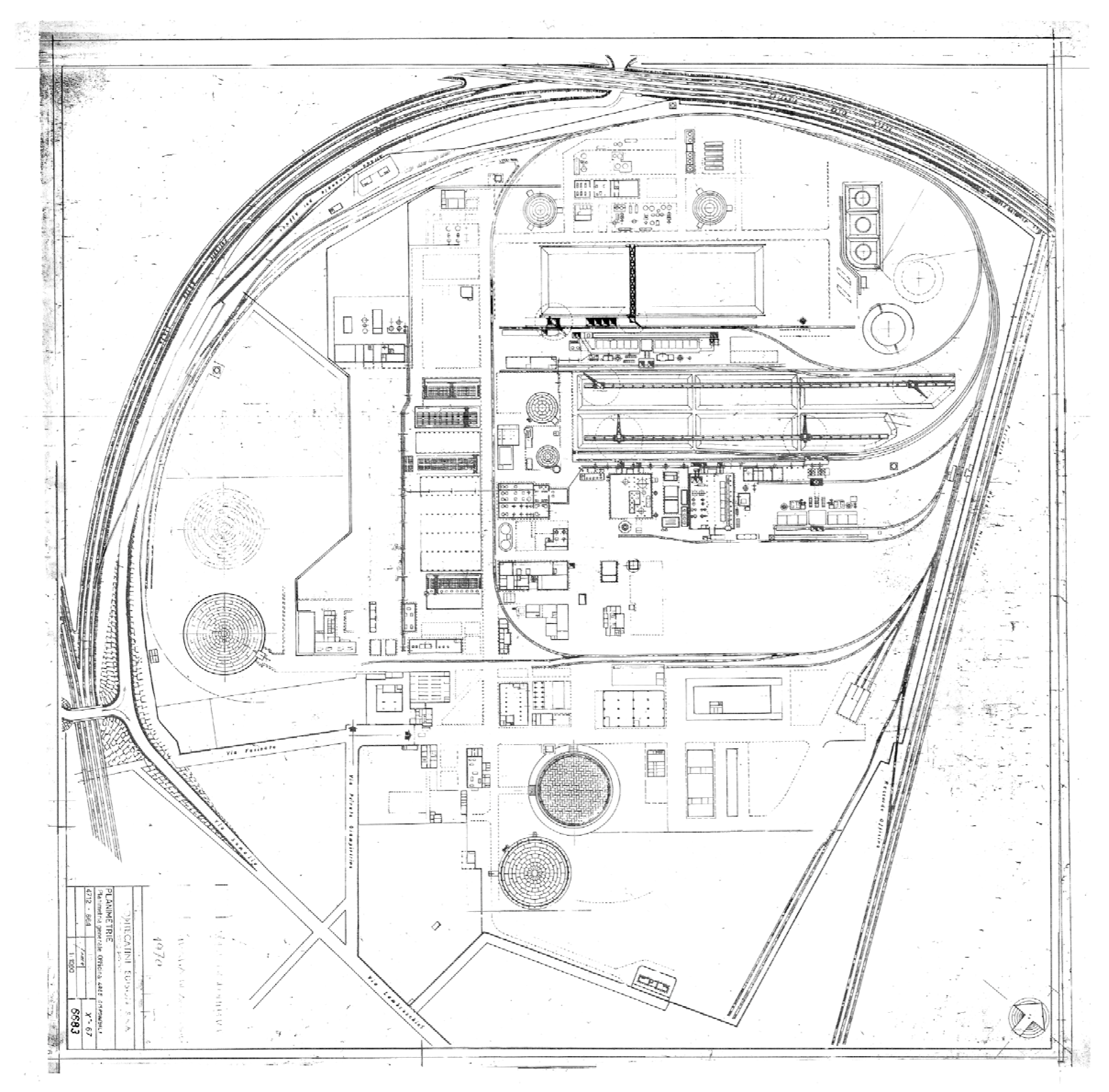
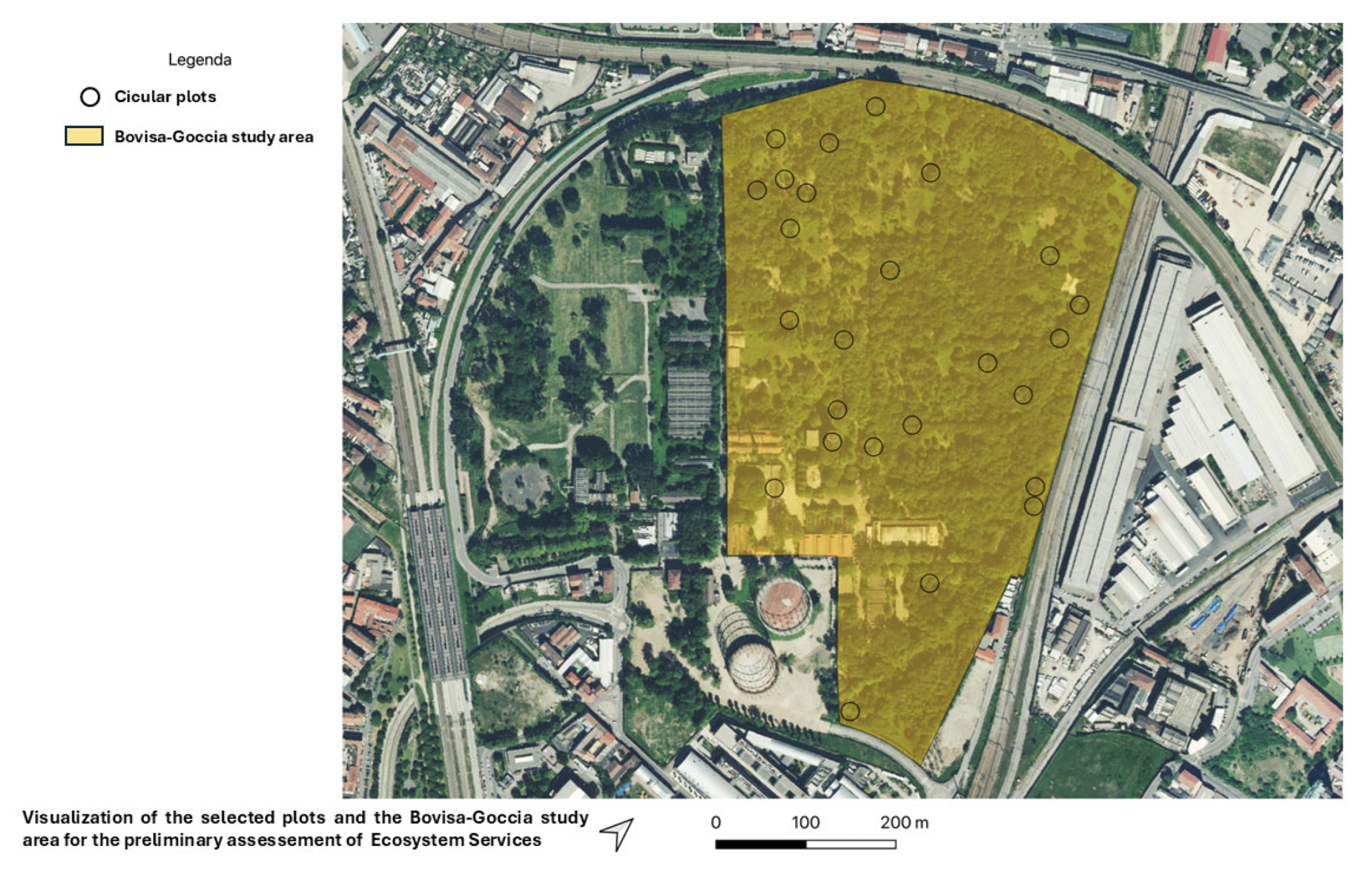
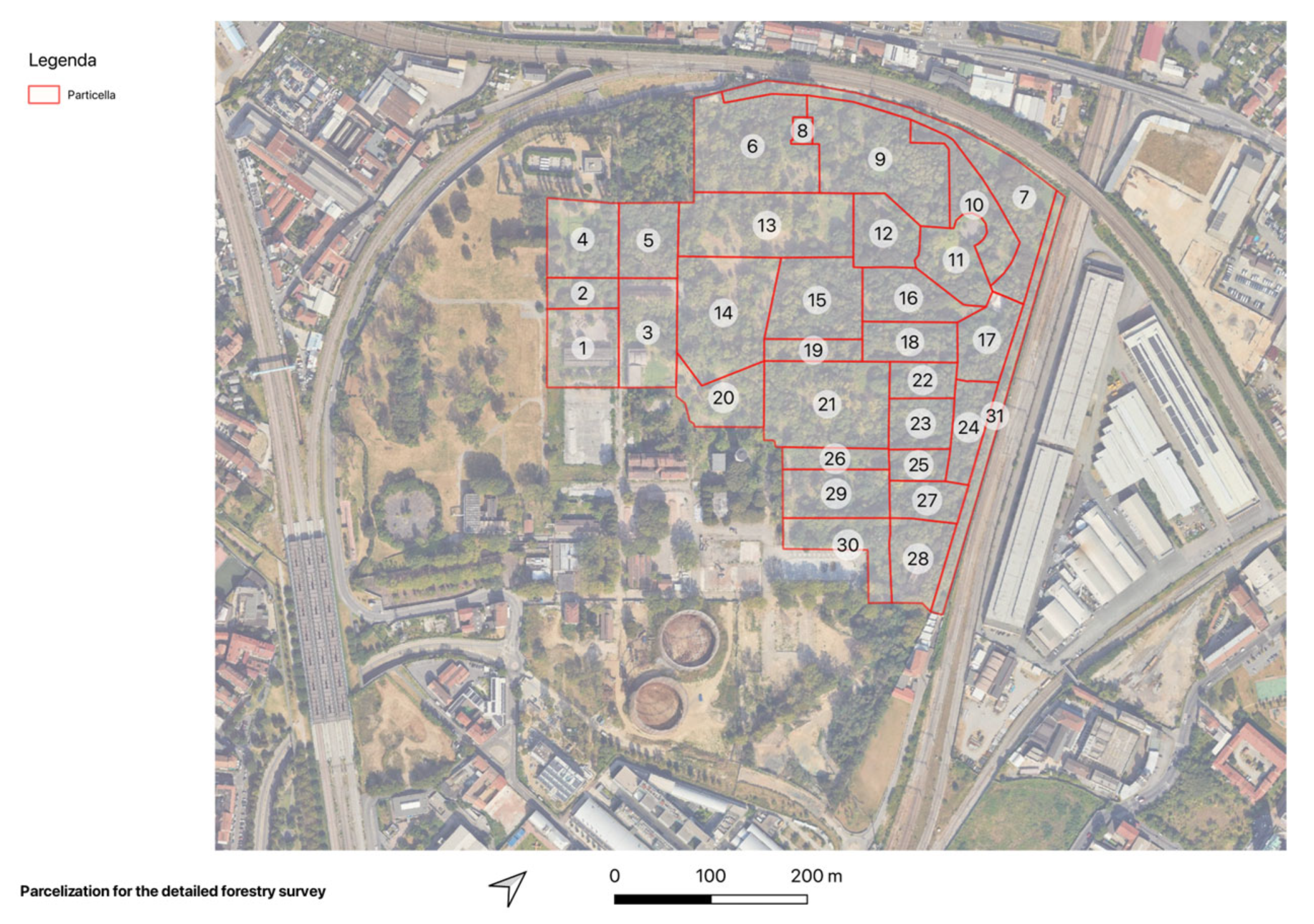
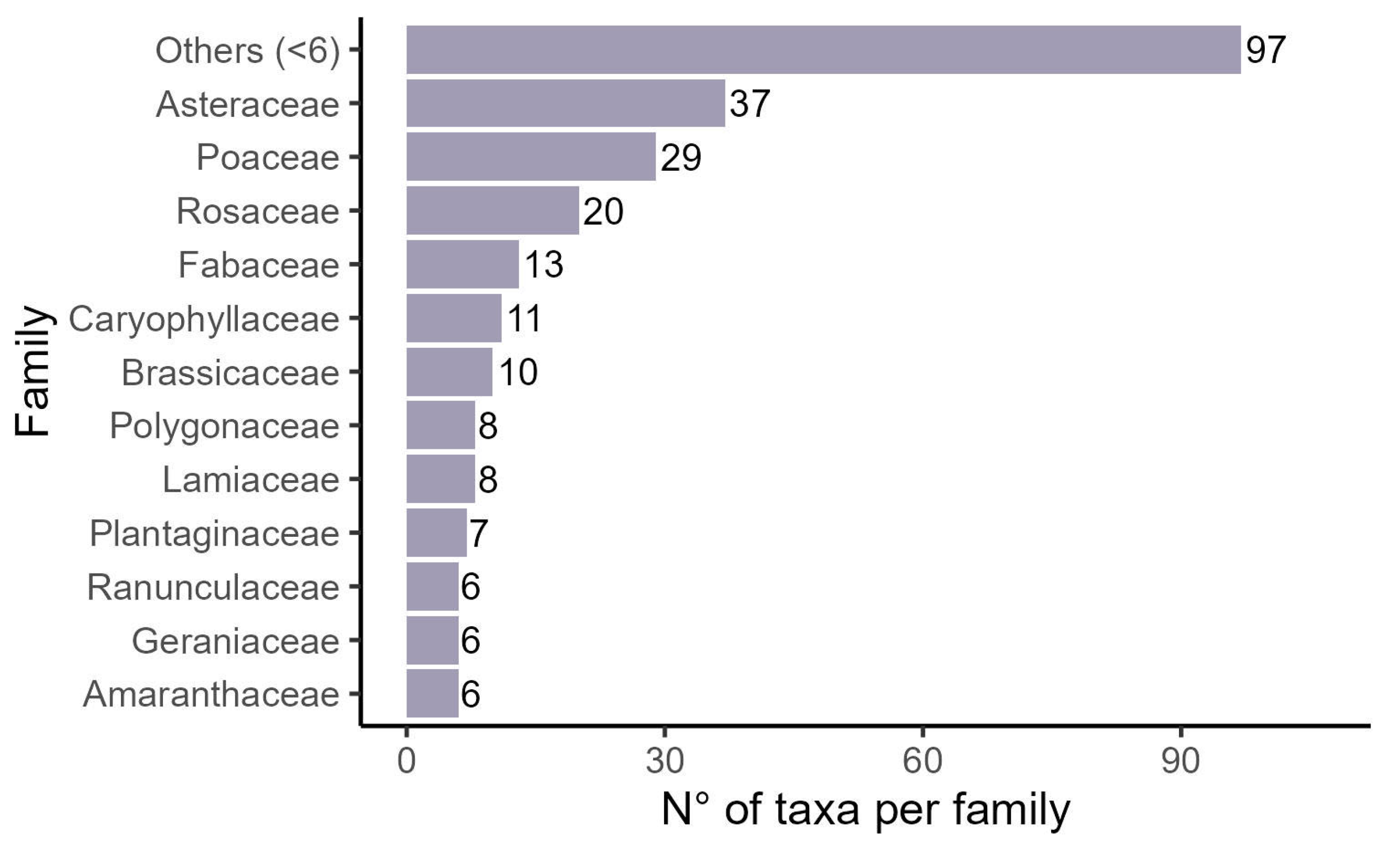
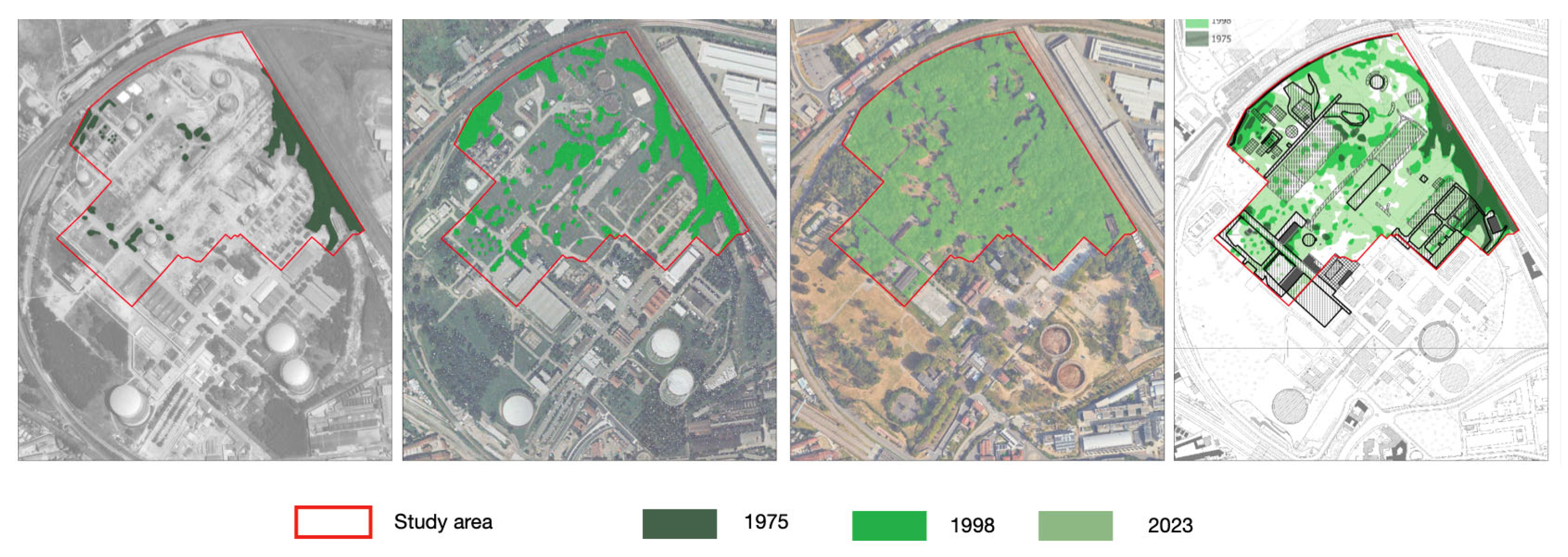
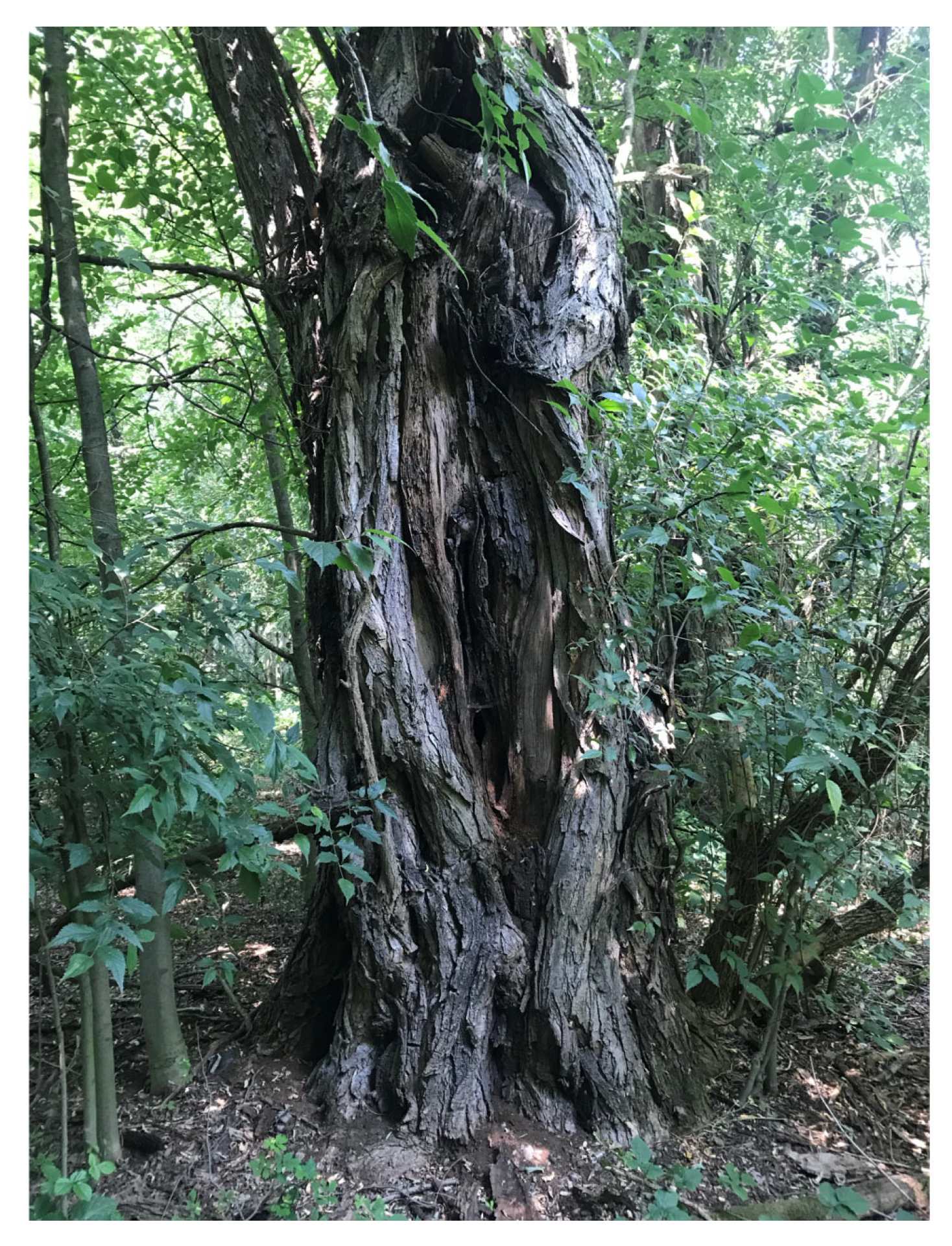

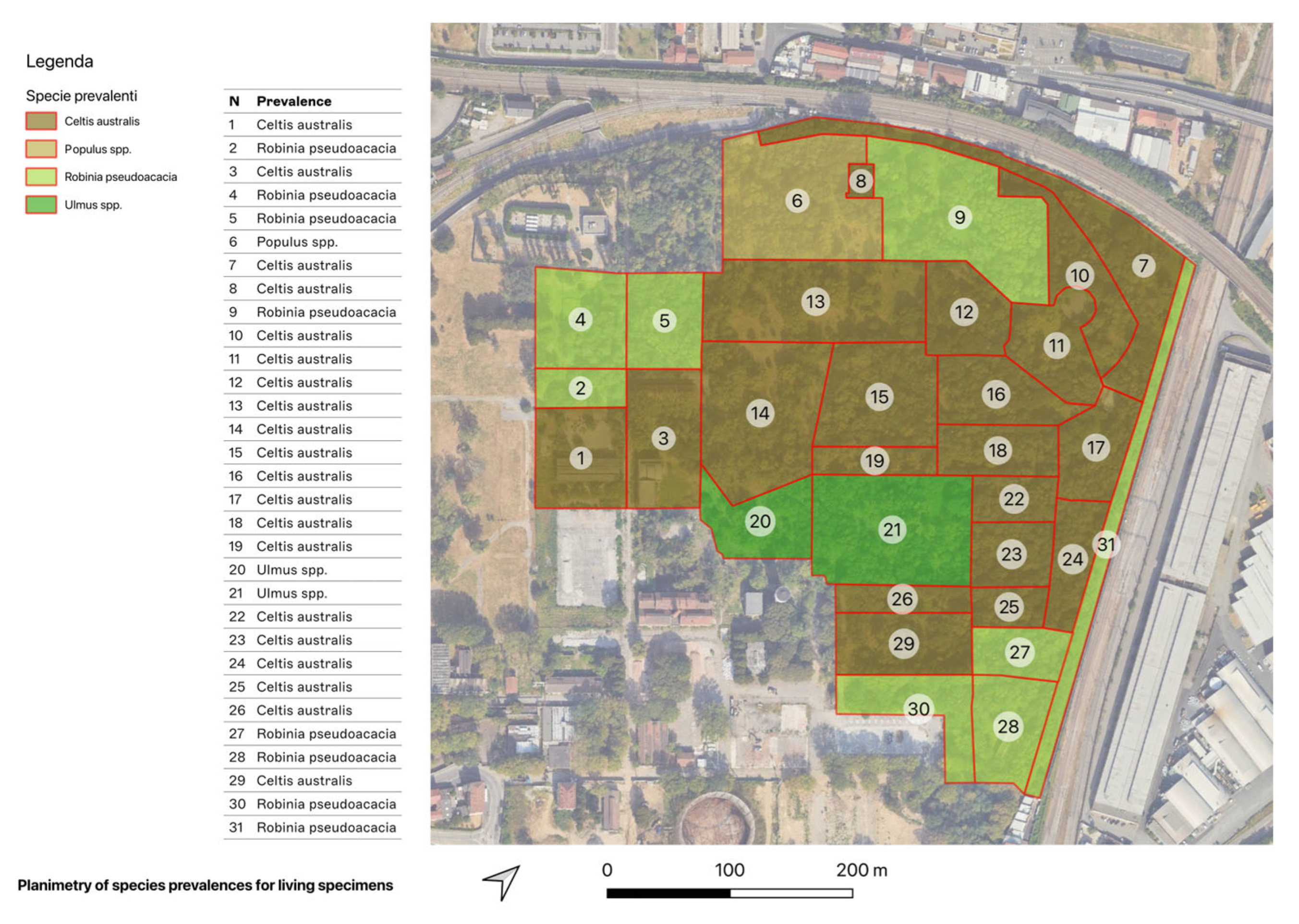
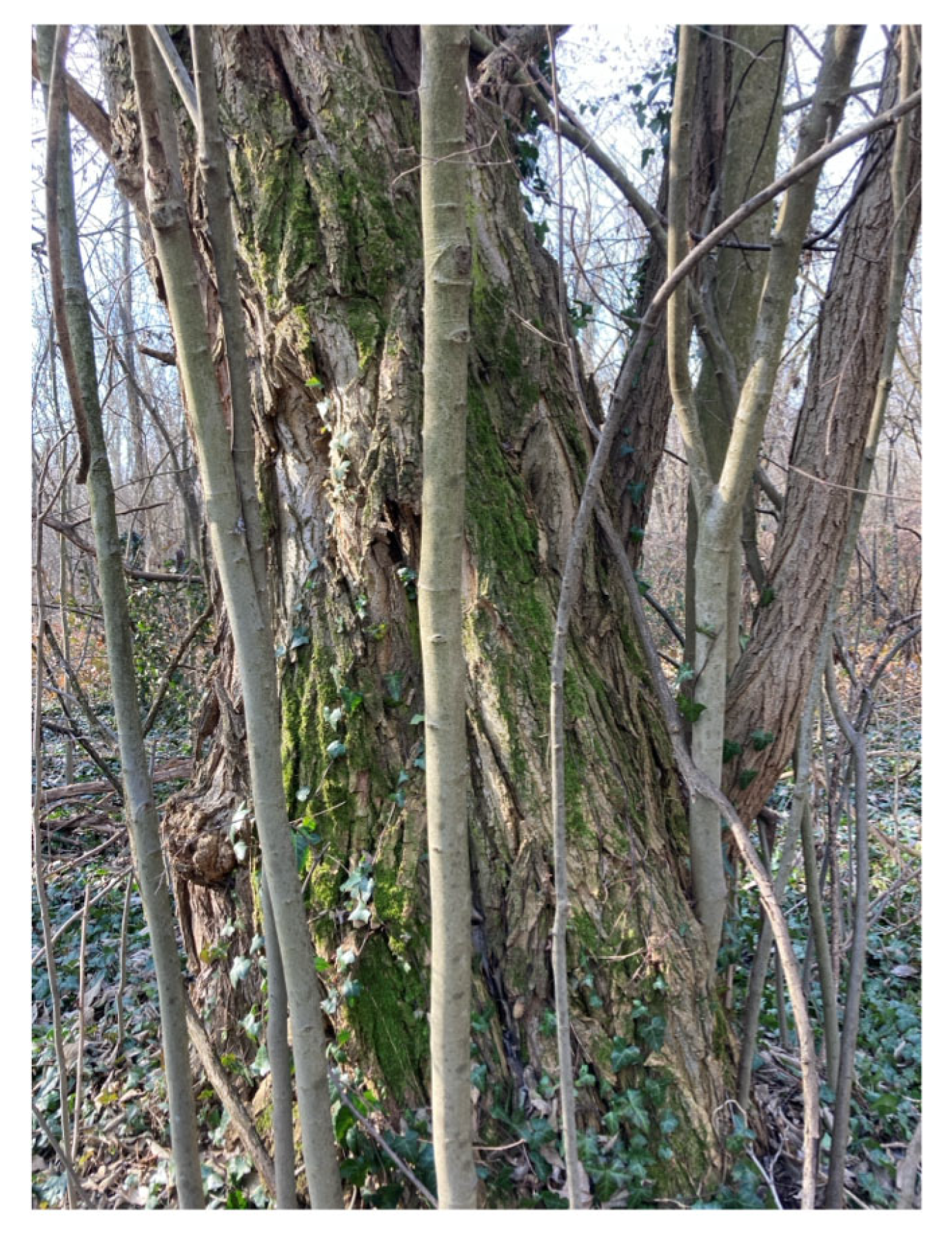
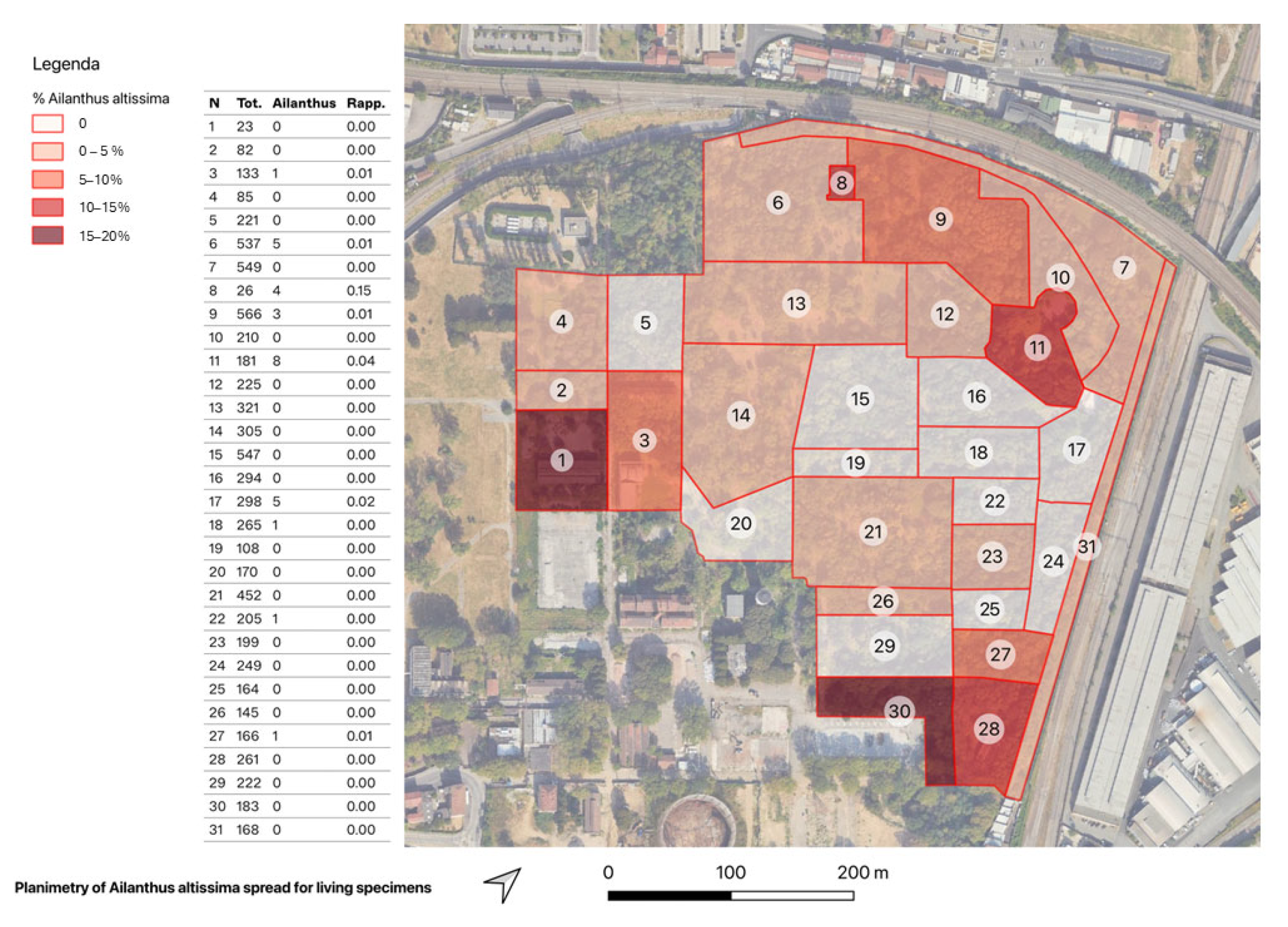
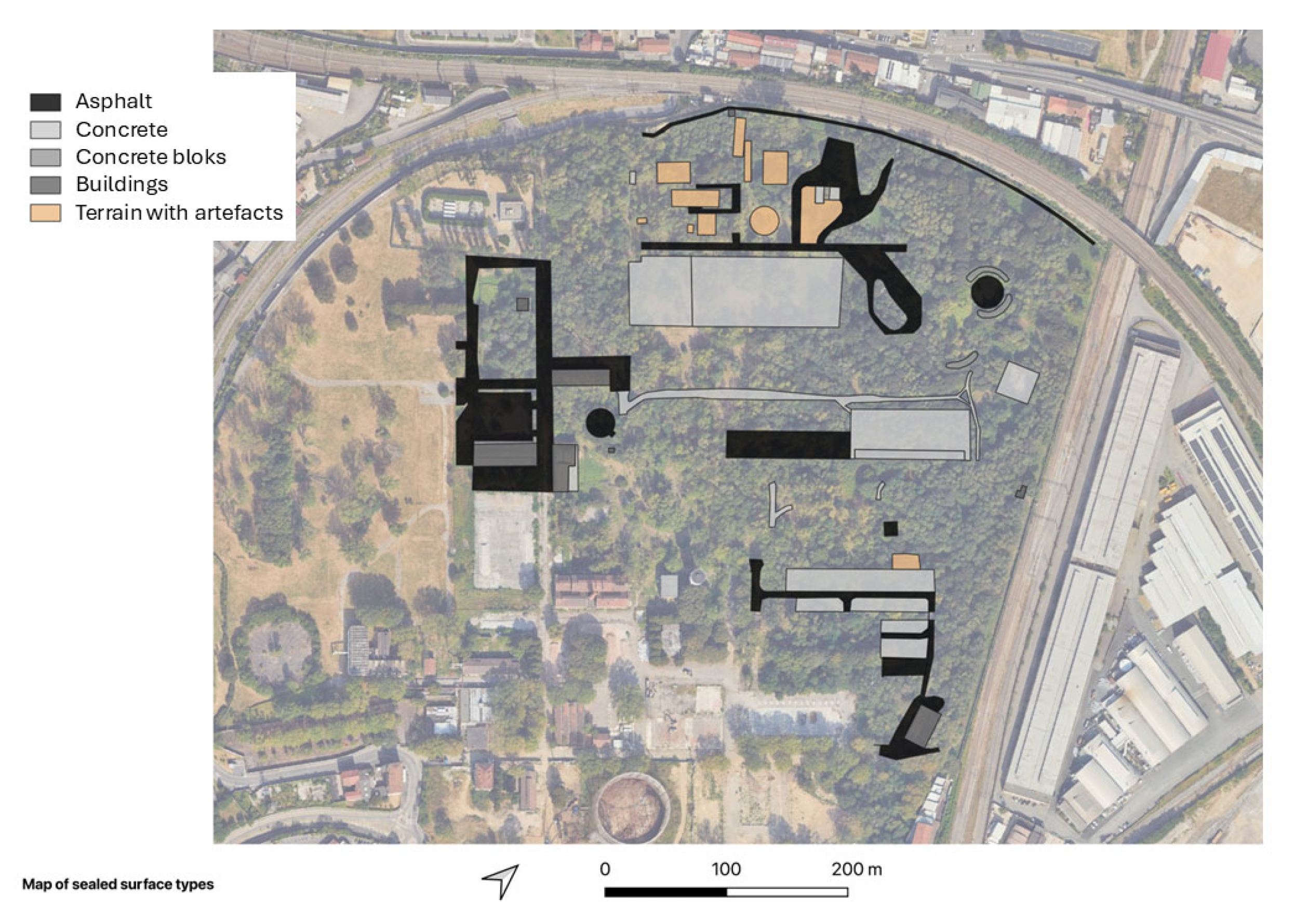

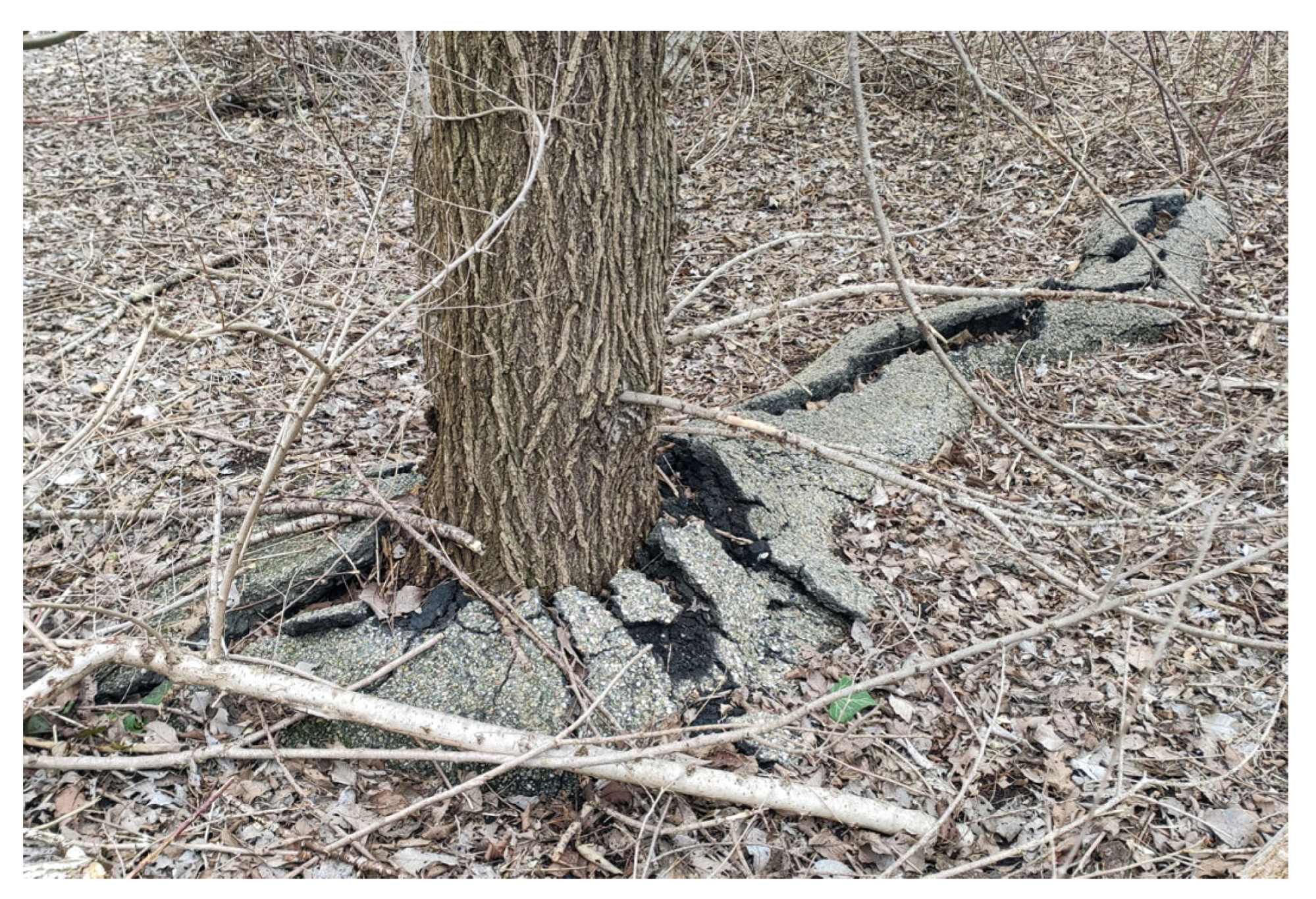

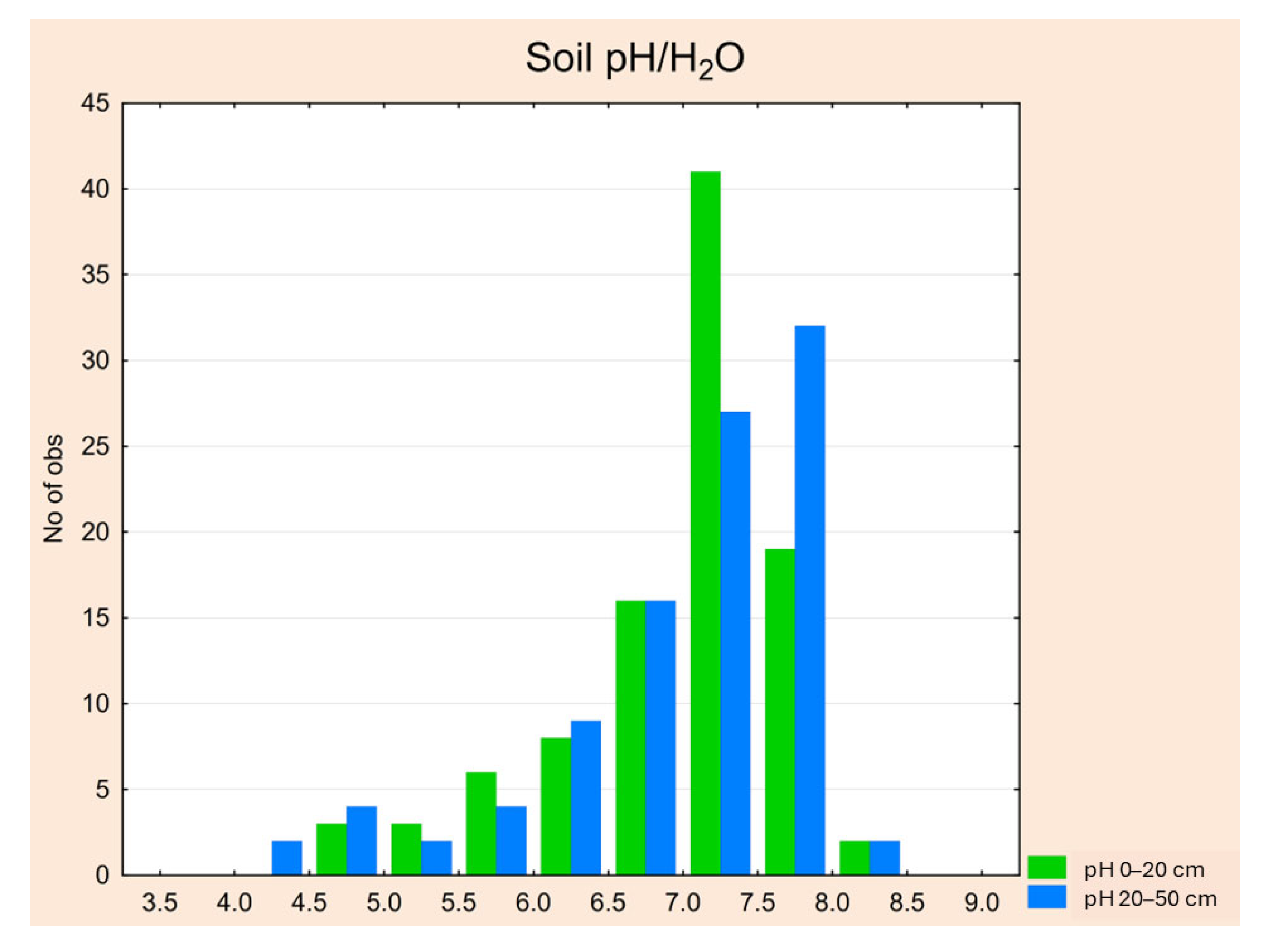
| Ecosystem Service | Indicator | Unit of Measure | Amount |
|---|---|---|---|
| Carbon storage and sequestration in biomass | Carbon storage | Metric tons of carbon | 3410 |
| Carbon sequestration potential | Metric tons of carbon per year | 77.72 | |
| Net carbon sequestration | Metric tons of carbon per year | 67.12 | |
| Regulation of urban hydrology | Surface runoff reduction | Cubic meters per year | 1780 |
| Reduction in airborne particulate matter pollution | Air pollution removal (particulate matter less than 2.5 microns) | Metric tons per year | 1.389 |
Disclaimer/Publisher’s Note: The statements, opinions and data contained in all publications are solely those of the individual author(s) and contributor(s) and not of MDPI and/or the editor(s). MDPI and/or the editor(s) disclaim responsibility for any injury to people or property resulting from any ideas, methods, instructions or products referred to in the content. |
© 2025 by the authors. Licensee MDPI, Basel, Switzerland. This article is an open access article distributed under the terms and conditions of the Creative Commons Attribution (CC BY) license (https://creativecommons.org/licenses/by/4.0/).
Share and Cite
Rapaccini, G.; Porro, Z.; Passatore, L.; Trentanovi, G.; Zoderer, B.M.; Pirelli, P.; Guerci, L.; Galasso, G.; Quaglini, L.A.; Cardarelli, E.; et al. Interdisciplinary Approach to Regenerate Contaminated Urban Sites with Novel Ecosystems: The Multi-Layer Analysis of La Goccia Forest, a Case Study in Milan. Forests 2025, 16, 1410. https://doi.org/10.3390/f16091410
Rapaccini G, Porro Z, Passatore L, Trentanovi G, Zoderer BM, Pirelli P, Guerci L, Galasso G, Quaglini LA, Cardarelli E, et al. Interdisciplinary Approach to Regenerate Contaminated Urban Sites with Novel Ecosystems: The Multi-Layer Analysis of La Goccia Forest, a Case Study in Milan. Forests. 2025; 16(9):1410. https://doi.org/10.3390/f16091410
Chicago/Turabian StyleRapaccini, Gianluca, Zeno Porro, Laura Passatore, Giovanni Trentanovi, Brenda Maria Zoderer, Paola Pirelli, Lorenzo Guerci, Gabriele Galasso, Lara Assunta Quaglini, Elisa Cardarelli, and et al. 2025. "Interdisciplinary Approach to Regenerate Contaminated Urban Sites with Novel Ecosystems: The Multi-Layer Analysis of La Goccia Forest, a Case Study in Milan" Forests 16, no. 9: 1410. https://doi.org/10.3390/f16091410
APA StyleRapaccini, G., Porro, Z., Passatore, L., Trentanovi, G., Zoderer, B. M., Pirelli, P., Guerci, L., Galasso, G., Quaglini, L. A., Cardarelli, E., Stefanelli, S., Comolli, R., Ferré, C., Gheza, G., & Zacchini, M. (2025). Interdisciplinary Approach to Regenerate Contaminated Urban Sites with Novel Ecosystems: The Multi-Layer Analysis of La Goccia Forest, a Case Study in Milan. Forests, 16(9), 1410. https://doi.org/10.3390/f16091410









